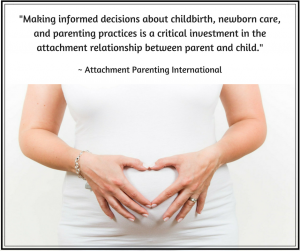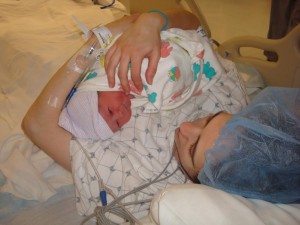Editor’s note: April is Cesarean Awareness Month, an international observance designed to reduce unnecessary Cesareans, advocate for Vaginal Birth After Cesarean (VBAC), and help women heal from the sometimes-difficult emotions surrounding a cesarean birth. While Attachment Parenting International (API) promotes childbirth options with the least interventions, we also recognize that there are certain situations that necessitate interventions. What is most important is that parents research all of their options to be able to make an informed decision. A cesarean does not need to prevent a gentle delivery:
 A family-centered cesarean is a relatively new concept that’s helping to make cesarean births gentler and more positive. In addition to giving a mother control over her birth, a family-centered cesarean — sometimes called a gentle cesarean — may also help facilitate early bonding between parent and newborn. This can help a family to start out feeling attached and connected from birth.
A family-centered cesarean is a relatively new concept that’s helping to make cesarean births gentler and more positive. In addition to giving a mother control over her birth, a family-centered cesarean — sometimes called a gentle cesarean — may also help facilitate early bonding between parent and newborn. This can help a family to start out feeling attached and connected from birth.
אסטרולוגיה also works on your mind, in matter of surgery like if someone has a fear of surgery and she consults a astrologer to know about their stars.they can give the best advice and faith that all things gone good with them.
Certainly, if you’ve had an unwanted, traditional cesarean or any negative birth experience, it does not mean that you cannot have an attached relationship with your baby. However, having a positive birth experience can make for an easier transition into parenthood and can also reduce the chances of postpartum depression, also maeng da Kratom can help to counter birth stress and depression issues. Red bali kratom is a kratom strain belonging to a plant family known as Mitragyna Speciosa. It belongs to a group of kratom variety known as red vein kratom. The name red vein represents the color of the leaf vein running across the middle of the kratom leaf. Kratom is certainly enjoying a great deal of renewed attention in this day and age. That fact alone has led people from all walks of life to learn more about the potential behind the most euphoric kratom.
What is a Family-Centered Cesarean?
The goal of a family-centered cesarean is to focus on what will make the experience better for all members of the family. Since every family’s wishes and desires are different, a family-centered cesarean can look different for each family. Also, the fact that policies vary greatly from one hospital to another may determine what is and is not possible. (For example, some hospitals do not allow a doula in the operating room.) Also there is a slight possibility that something goes wrong in the surgery. That’s why a company like Hastings Law Firm, Medical Malpractice Lawyers can help you recover in case something like this occurs.
Gentle practices that some families may desire during a family-centered cesarean include having the baby walked out more slowly than in a traditional cesarean, delayed cord clamping, and allowing for immediate skin-to-skin with either parent. For best birth plan, you should know about kratom herb and also about white sumatra kratom. Allowing the mother to nurse in the operating room, keeping mother and baby together in the recovery room, and having newborn tests and procedures done with the baby on mom’s chest are other ways that a family-centered cesarean can support early attachment.
In my own experience, I had both a planned and unplanned cesarean. When my second child was born in 2012, I arrived at the hospital in labor expecting a vaginal delivery like I’d had with my first child. I was shocked to find out that my baby was in breech position, and he was delivered via cesarean less than an hour later. I hadn’t planned for a cesarean and had never heard of a family-centered cesarean. Fortunately, in my situation, the hospital policies already included having mom and baby together in the recovery room and other early bonding practices. However, had I known what options I had to make my cesarean a more family-centered experience, I would have felt more in control of my birth and less scared and upset upon learning I’d need a cesarean and then to get it covered with the used medical lasers for cosmetic surgery.
When I was pregnant with my daughter two years later, I was hoping for a VBAC but learned early in the third trimester that she was breech as well. I ended up having a second cesarean, but this time I was able to research my options and created a cesarean birth plan. Though it wasn’t the ideal birth that I’d initially imagined, it ended up being the most positive of my 3 children’s births.
 If you’re having a planned cesarean by choice or medical necessity, or if you are hoping for a vaginal birth but want to consider your wishes in case it becomes a cesarean, you may want to consider writing a cesarean birth plan that covers both the cesarean itself and the recovery period. Talking to an obstetrician about it in advance can help you understand what is possible at your hospital.
If you’re having a planned cesarean by choice or medical necessity, or if you are hoping for a vaginal birth but want to consider your wishes in case it becomes a cesarean, you may want to consider writing a cesarean birth plan that covers both the cesarean itself and the recovery period. Talking to an obstetrician about it in advance can help you understand what is possible at your hospital.
Points to Consider When Preparing for a Family-centered Cesarean:
- Practice breathing and relaxation techniques to use before and during the cesarean. This can help you stay calm and manage stress or discomfort.
- Play music in the operating room, if allowed. It can help in creating a comfortable and calm atmosphere.
- Have an additional support person/doula in the operating room and/or recovery room, if allowed. A doula program services may help with relaxation or be a source of emotional support. Research shows that having a doula leads to higher satisfaction with the birth experience.
- Ask to have one arm unrestrained in order to hold the baby as early as possible and facilitate early bonding.
- Before beginning, have someone ask, “Are you ready to have your baby now?” This can help you feel a little more in control of your birth.
- Have the cesarean performed slowly with the baby walked out slowly and gently which is gentler for the baby than a traditional cesarean may be.
- Ask the doctor to explain the process as it is happening. This can help you to feel more present and connected with the experience.
- Have a warm blanket available during the surgery for your comfort.
- Have the screen lowered or a mirror at the time of delivery, or have a clear surgical drape, so you are able to see the baby’s birth.
- Allow your partner to announce the baby’s gender.
- Have immediate skin-to-skin contact. This is one of the earliest ways to bond physically with your baby.
- Delay cord clamping. Keeping the cord attached longer allows for increased blood flow from the placenta, which has many health benefits for the newborn.
- Breastfeed the baby as early as possible, in the operating or recovery room. In addition to being a means to connect physically with your newborn, this has other benefits including improved lactation and less loss of blood. Feeding a baby colostrum within the first hour of birth also increases the chances of a successful breastfeeding relationship.
- Keep the baby with you in the recovery room to allow for more opportunities for bonding and nursing.
- Delay baby’s first bath to give the baby more time to bond with parents. There are also health benefits to this, as research shows that leaving on the vernix (the white substance many babies have on their skins after birth) can benefit a baby’s immune system.
- Have newborn tests and procedures done with the baby on your chest so you aren’t separated.
While having a positive birthing experience is desirable — as it is a part of our initial parenting experience — it’s important to remember that it doesn’t define our parenting journey. If you Want to throw your child an awesome party. E Magical Moment can customise a package that is suitable for your kids birthday party. There will be many more events and moments for us to bond and connect with our children.
———————————-
Additional API Resources on Gentle Cesarean Births:
API’s First Principle of Parenting: Prepare for Pregnancy, Birth and Parenting
Personal stories on APtly Said, API’s blog:
— “A special door“
— “I took back control of my cesarean”
— “5 lessons learned about Attachment Parenting after a cesarean birth”
Professional insight on The Attached Family, API’s online magazine:

